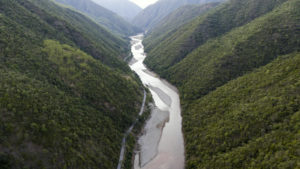China faces a turbulent economic and geopolitical landscape, with most of the world still battling Covid-19, relations with the US at a new low, and the global economy hard hit.
So is the environment still a priority in its political and economic agenda?
Immediately after the lockdown was partially lifted in March, China’s president, Xi Jinping, visited Anji County in east China’s Zhejiang province and Niubeiliang National Nature Reserve in Shanxi, two important locations where his idea of ecological conservation developed. The visits sent strong signals that the environment still mattered for the leadership. Premier Li Keqiang’s work report for 2020, delivered to the National People’s Congress at its post-lockdown Twin Sessions convention in late May, also highlighted environmental protection. Moreover, Huang Runqiu, the newly appointed minister of ecology and environment, stressed that ecological protection and green development shall remain priorities and acknowledged that work is still needed to achieve China’s 2020 environmental goals.
Beyond visits and statements from top leaders, China has been rolling out a series of policy and legislative items since March with far-reaching implications for its environmental governance system. We take stock of four major developments in this area to demonstrate how they will bear out the leadership’s vision for ecological civilisation in the post-pandemic era.
‘Modernising’ environmental governance
In March, the Party Central Committee and the State Council issued the “Guiding Opinions on Building a Modern Environmental Governance System”, which specifies the roles of various stakeholders in environmental protection, and reaffirms key priorities, such as rule of law, multi-stakeholder governance, transparency and market mechanisms. The document includes the objective of setting up a green governance system that is “clear in its direction”, “scientific in decision making”, “strong in enforcement”, “effective in its incentives” and “wide in participation” by the year 2025.
While most of the systems have been announced in previous documents, the Guiding Opinions document goes further by providing a convenient to-do list for environmental governance reform in the 14th Five Year Plan period (2021-2025).
Importantly, the roles of the Party Central Committee and National Development and Reform Commission (NDRC) are specified, as well as the role of the Ministry of Ecology and Environment (MEE). This matters, because issues like climate change must be addressed by integrating climate considerations into broader economic policies, such as industrial restructuring, power generation and transportation. The MEE recently established a “general department” tasked with this type of integration, among other things.
Multi-stakeholder participation will be the key feature of the modern environmental governance system. The Guiding Opinions document stresses the importance of businesses and civil society participating, and clarifies their responsibilities as well as government’s. Moreover, it explicitly mentions strengthening judicial support for environmental protection and encouraging prosecutors in bringing environmental public interest lawsuits.
A ‘green’ Civil Code
The Civil Code, passed at the latest Twin Sessions on 28 May, is the only Chinese legislation officially called a “code”. It contains ambitious goals for state governance, including 18 “green articles” dedicated to safeguarding the environmental rule of law, with many more newly added provisions aimed at promoting environmental protection.
To be more specific, the Civil Code makes sustainable utilisation of resources and environmental protection a prerequisite for exercising land-use rights. It has a dedicated chapter on environmental pollution and damage liabilities, with some major revisions to environmental tort liability:
- Responsible parties are no longer called “polluters” but “tortfeasors”, meaning they have committed a tort – a civil offence. Anyone causing ecological damage, not just narrowly defined “pollution” as stipulated in the Tort Law, must assume tort liabilities.
- Punitive compensation for ecological damage is introduced, which increases liability if conduct was malicious, raising the cost of breaking the law.
- If the tortfeasor is slow to remediate, government may conduct remediation by itself or by entrusting others at the expense of the tortfeasor.
- The code expands the scope of compensation, including losses from permanent ecological damage and loss of ecological service functions during remediation; expenses related to investigating, authenticating and assessing ecological and environmental damage, pollution clean-up, and ecological and environmental remediation; as well as expenses to prevent the occurrence and aggravation of damage. This implies that the expenses to be paid by the tortfeasor may include preventive costs arising from the adoption of precautionary, preventive and control measures.
- More elements are accounted for in determining the liability when multiple parties are jointly liable. This will facilitate adjudication in such cases, which can be common in environmental problems, such as air or water pollution.
Preventive public interest litigation
The system for environmental public interest litigation has quickly taken shape since the introduction of China’s revised Environmental Protection Law in 2015, with hundreds of cases brought by public prosecutors and NGOs. In May, the Environmental and Resource Tribunal of the Supreme People’s Court released its “White Paper on China’s Environmental and Resources Adjudications” in 2019, and the “Green Paper on China’s Environmental Justice Development” in 2019. This year’s edition of the white paper provides much more detail than before, and for the first time defines climate change cases in their own category.
The white paper instructs Chinese courts to handle cases concerning greenhouse gas emissions and ozone-depleting substances that directly or indirectly contribute to climate change in accordance with the law, and that these cases should be adjudicated with the aim of reducing greenhouse gas emissions or strengthening climate resilience, depending on the type of case. Creating a separate category for cases related to climate change has paved the way for furthering environmental judicial practice in response to the changing climate. Very few climate cases have been adjudicated before in China, in part due to the difficulty in bringing preventive litigation.
The pandemic has triggered a wide-ranging conversation about the relationship between human beings and nature
At the Twin Sessions recently concluded, proposals to support preventative environmental public interest litigation have been submitted by delegates. Moreover, both the Supreme People’s Court and Supreme People’s Procuratorate have signalled support for further development of systems for preventive litigation.
A recent joint study completed by the Supreme People’s Procuratorate and ClientEarth concluded that preventive environmental public interest litigation is an important area for future development.
By allowing interventions at an earlier stage before environmental damage takes place, the environment can be better protected, according to Judge Wang Xuguang, president of the Environmental and Resource Adjudication Tribunal of the Supreme People’s Court, at an interview during the Twin Sessions.
Multiple signals, from the progress of the Green peafowl case, to the proposals by delegates at the Twin Sessions, and to the support from the Procuratorate and the Court, also show that the system for preventive environmental litigation is now a priority. And with Covid-19’s suspected link to wildlife, the entire chain of illegal wildlife trade (illegal killings, capture, smuggling, trade, sales and purchases) have also become a top priority for China’s public interest prosecutors.
A truly green transition?
Despite heavy turbulence caused by Covid-19 and the economic downturn, recent developments show that environmental issues remain a key focus area in China. The impacts of the pandemic, rather than halting the development of environmental rule of law, have triggered a wide-ranging conversation about the relationship between human beings and nature, leading to further progress in the strengthening of environmental governance in China.
One big outstanding point to watch is whether China will actively “green” its post Covid-19 stimulus measures, unveiled at the Twin Sessions by Premier Li. As a huge amount of government spending will be made in a short period of time, it is an excellent opportunity to test if China’s evolving green policies and legislations translate into a truly green and low-carbon transition.








